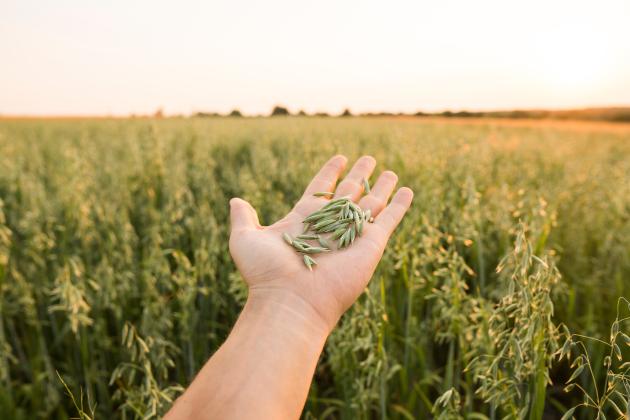Keith VanSkike - Twin Creeks Extension, Agronomy & Natural Resources
If used as an early spring cover crop with some grazing, spring oats can provide some extra income. If used as a pure forage crop with reasonable fertilizer inputs, spring oats can provide an excellent bridge for producers short on available pasture in April and May until perennial pasture or summer annual forage production becomes available.
Oat pasture should be treated the same as winter wheat pasture in terms of stocking rates and time to initiate grazing. Spring-planted oats can produce 1,500 to 2,000 lbs. dry forage per acre if fertilized with about 75 lbs. N /acre. Oat pasture should be treated the same as winter wheat pasture in terms of stocking rates and time to initiate grazing. Grazing should not be initiated before a well-established rooting system that provides good anchorage of young plants to the soil, which generally occurs when plants are six inches tall or more. One acre of spring-planted oats can provide about 60 days of grazing to a 750 lbs. animal at a 1.5 animal/acre stocking rate.
Since grain production of oats is not practical or recommended under grazing, producers should treat oat pasture as a graze-out program or remove it when ready for the next crop. Oats are easily controlled by a variety of herbicides, such as glyphosate and atrazine. The length of effective grazing is a function of stocking rate, weather, and subsequent cropping plans. Rotational grazing may extend the window for effective pasture production.
For hay, late boot to early heading is the optimal timing to balance quantity with quality considerations. Harvested at the dough stage, hay should have an approximate total digestible nutrient (TDN) of 56% with 10% protein, both on a dry basis. A nitrate test is recommended. Prussic acid levels should not be a concern.
Silage is another option for spring oats. Oats should be harvested for silage from late milk through early dough stages. Expect silage with a TDN of approximately 60% and 9% protein on a dry weight basis.
Before planting oats, check the herbicide history of the desired field. Oats are especially sensitive to triazine herbicides. The optimal planting date depends on location. In northwest Kansas, the optimal date is from the first week of March through the end of March. For most of the state, planting is recommended from late February through the mid-March and should not be considered later than April 10. Oat should be drilled at a seeding rate of 100 to 120 lbs. per acre. Oat seedlings are less vigorous than wheat and can experience difficulties emerging at deeper planting depths, especially after crusting rains. It is not recommended to cut down on seeding rate because spring tillering might be limited and oat forage yield may, in some cases, heavily rely on the production of main tillers.

